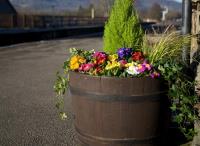 Add My Company
Add My Company
Sign In
Choosing a container that's fit for purpose
14-12-2015

Obviously we are big supporters of container gardening. Containers offer versatility, mobility, convenience and flexibility - and they work beautifully when combined with flower beds in a whole range of public spaces, from car parks to town centres. We have seen councils, schools, theme parks, Britain in Bloom groups and individual gardeners make imaginative use of self-watering containers to create some truly stunning displays.
However, there are so many styles and sizes of containers on the market, made from such a wide variety of materials that it can be difficult to choose. Of course, you want your containers to look good, but there are other factors to consider which can impact on the longevity and suitability of different types of planter. Each type has its own pros and cons.
Self-watering: creating optimal conditions for growth, Amberol containers have a sub-soil water reservoir and unique Aquafeed™ capillary action matting system that disperses water and nutrients as required. Evaporation is minimised and the roots absorb only what they need. Designed for easy maintenance, each planter has a filling point which rarely needs to be topped up more than once a week.
Plastic: a universally flexible and hardy material, plastic is a great choice for planters. Difficult to break and lighter and easier to manoeuvre, they don’t dry out as much as clay or terracotta pots. Furthermore, with improved designs and manufacturing techniques, plastic containers look more attractive than in the past. Some even look like wood, terracotta or stone, but with the increased durability that plastic can offer. With issues of sustainability in mind, all Amberol’s self-watering containers and planterware are made from recyclable polyethylene.
Glazed ceramic and terracotta: the warm hue of clay and terracotta is attractive, but it does dry out faster than plastic and is also prone to cracking when exposed to severe or prolonged frost. If opting for this material, look for frost-proof pots. Positioning pots on feet can also help reduce the risk of frost damage.
Wood: another attractive material which enhances the integration with the natural environment. However, it does rot over time. Treating the wood and lining containers with punctured plastic sheeting can help extend their longevity. Half barrels are often used for growing fruit trees and Amberol has developed it’s very own half barrel which looks like wood, but is actually made from recycled polyethylene.
Metal: contemporary and attractive, metal containers have become increasingly popular. They are practical as they don’t crack in the cold or rot. However, they are susceptible to external temperatures, heating and cooling quickly. They may also rust.
So, before choosing your container decide which criteria are most important to you: durability, aesthetics, growing conditions, green issues – and make your decision accordingly. At Amberol we think all these properties are essential – and so we have done our best to incorporate them all in our self-watering products.
For more information on Choosing a container that's fit for purpose talk to Amberol Ltd
Enquire Now
More News
List your company on FindTheNeedle.

